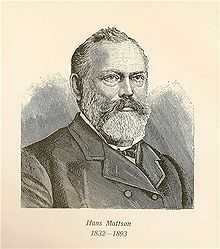Hans Mattson

Hans Mattson (December 23, 1832, Önnestad – March 5, 1893) was a Swedish American politician who emigrated from Skåne in the south of Sweden to North America in 1851 and settled in Goodhue County, Minnesota. He served with distinction as a colonel in the American Civil War (1861–65) and in 1869 became Minnesota's Secretary of State. Mattson was born in 1832, on a small farm in southern Sweden. In 1851, he immigrated to the U.S. with a friend. He settled on a farm in an established Swedish colony in Illinois in 1853 and brought his family from Sweden to join him. But Mattson did not find Illinois promising. He left in search of better land just a few months after settling there.
In August 1853, Mattson led a group of several hundred Swedish immigrants to settle in Goodhue County, Minnesota.[1] The settlement was soon known as Vasa, and it became home to prominent Swedish Americans including Governor John Lind. Mattson left the colony in 1856 for Red Wing. Yet new immigrants continued to arrive, sustaining Vasa's Swedish culture.[2]
Shortly after moving to Red Wing, Mattson was financially ruined by the panic of 1857. He and his wife, Cherstin, had to start over. After getting on his feet again, Mattson was admitted to the bar and chose to pursue public life. He was elected city clerk of Red Wing in 1859 before becoming county auditor.[2]
At the start of the Civil War in 1861, Mattson raised a company of Swedes and Norwegians to fight for the Union. Mattson was revered for his leadership of the Third Minnesota Regiment. He returned to Red Wing at the end of the war in 1865 at the rank of colonel.[2]
After returning to Minnesota, Mattson began his work as an immigration booster. First he worked for private railroad companies. He started with the St. Paul & Pacific Railroad Co, where he worked as a protection agent to greet Swedish and Norwegian arrivals in Chicago.[2]
Building on his experience, in 1866, Mattson proposed the creation of a state Board of Immigration. The board would recruit immigrants to homestead land in Minnesota. Until the 1880s, immigration to the U.S. was regulated by states rather than the federal government. In 1867, Governor William Marshall established the board and named Mattson to be its first secretary. The state was especially interested in recruiting Scandinavian immigrants, who were considered to have good moral character.[2]
Mattson returned to Sweden as representative of the Minnesota Immigration Board in 1867 and 1868 to recruit settlers, a successful undertaking. He returned again several times in the 1870s as emigrant agent for the Northern Pacific Railroad. These visits are described in his memoirs Reminiscences, which were published in both English and Swedish in 1891, and which show Mattson viewing the social snobbery of his old home country with a sardonic eye.
As a booster, Mattson promoted Minnesota in Sweden and Norway. He also promoted the state to Scandinavian immigrant communities in the Eastern U.S. Mattson recruited immigrants to Minnesota by several means. He wrote for Swedish American newspapers; he encouraged immigrants to write letters to friends and family in Europe; and he published pamphlets about the benefits of Minnesota. During the course of his life, Mattson founded several Swedish newspapers in Chicago and Minneapolis, including the Minnesota Stats Tidning.[2]
In 1870, Mattson was asked to run for Secretary of State. Scandinavian influence in Minnesota was growing, and the Republican Party sought Swedish and Norwegian candidates for office. Mattson was elected, becoming the first Swede elected to office in Minnesota. Mattson left the position in 1872, but he was re-elected and served again from 1887-1891. As a politician, Mattson promoted pan-Scandinavian unity, even though Swedish and Norwegian immigrants often were at odds.[2]
In between his stints as Secretary of State, Mattson lived outside the U.S. He took his family to Sweden in the spring of 1871. He remained in Sweden for five years as a booster. From 1881-1883, Mattson served as U.S. Consul General in India. President James A. Garfield offered him a diplomatic post because Mattson had become one of the most prominent Swedish Americans in U.S. politics. Aside from these trips abroad, Mattson lived most of his later life in Minneapolis. That is where he died, on March 5, 1893.[3]
Bibliography
- Atkins, Annette. Creating Minnesota: A History from the Inside Out. St. Paul: Minnesota Historical Society Pres, 2007.
- Burnquist, Joseph A.A., ed. Minnesota and Its People. Chicago: S. J. Clarke Publishing Company, 1924.
- Blegen, Theodore Christian. Minnesota, A History of the State. Minneapolis: University of Minnesota Press, 1963.
- Jaeger, Luth. "Hans Mattson," in Algot E. Strand, ed., A History of the Swedish-Americans of Minnesota. vol. 1. Chicago: Lewis Pub. Co., 1910.
- Ljungmark, Lars. For Sale-Minnesota; Organized Promotion of Scandinavian Immigration, 1866-1873.
- _____. Swedish Exodus. Translated by Kermit B. Westerberg. Carbondale: Southern Illinois University Press, 1979.
References
- ↑ http://www.waymarking.com/waymarks/WM1WDE_Vasa_Mattsons_Settlement
- ↑ 2.0 2.1 2.2 2.3 2.4 2.5 2.6 R.L. Cartwright (18 June 2012). "Mattson, Hans (1832-1893)". MNopedia. Minnesota Historical Society. Retrieved November 3, 2012.
- ↑ "Hans Mattson Dead," St. Paul Daily Globe, March 6, 1893.
- Barton, H. Arnold (1994). A Folk Divided: Homeland Swedes and Swedish Americans, 1840—1940, pp. 59–62. Uppsala: Acta Universitatis Upsaliensis.
 This article contains content from the Owl Edition of Nordisk familjebok, a Swedish encyclopedia published between 1904 and 1926, now in the public domain.
This article contains content from the Owl Edition of Nordisk familjebok, a Swedish encyclopedia published between 1904 and 1926, now in the public domain.
Written by R.L. Cartwright, 2012 and licensed under CC by-sa. Imported on 3 November 2012.